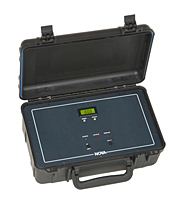|
|

|
|
Method of Detection |
 |
Temperature controlled zirconium oxide sensor in amperometric mode
|
 |
Ranges Available |
 |
314 - 0.2-25.0; 1.0-96.0% O2
314L - 2-200; 10-1,000; 100-10,000; 200-20,000; 500-50,000 PPM O2
|
 |
Resolution |
 |
1 PPM on PPM versions, 0.1% on percent versions
|
 |
Accuracy & Repeatability |
 |
±0.5% of full scale
|
 |
Drift |
 |
Span : 1% of reading per week (non accumulating)
Zero : 1% of reading
|
 |
Response Time (T-90) |
 |
2-3 seconds to 90% step change, depending on range
|
 |
Ambient Temperature Range |
 |
0 to 50 ºC
32 to 122 ºF
|
 |
|
Linearity |
 |
±0.5% of full scale
|
 |
Size & Weight |
 |
14" W x 6" H x 6 1/2" D @ 12 lbs (35 1/2 x 15 x 26 1/2 cm @ 5.5 kg)
|
 |
Power |
 |
AC/DC AC/DC Operation, 115 VAC, 60 Hz for recharging (Other voltages available.)
|
 |
Output Options |
 |
4-20 mA or 0-1 VDC
|
 |
Alarms |
 |
Low flow and O2 alarms
|
 |
Hazardous Area Rating Options |
 |
General Purpose, Non-Hazardous
|
 |
| |
|
For continuous high accuracy analysis from PPM to 96% Oxygen (O2) in process gas streams. Other applications include combustion air O2 enrichment, flue gas analysis, O2 deficiency analysis, and many more. Note: Sample gas must not contain combustible gases or vapors.
| |
|
- High accuracy, long-life zirconia O2 sensor
- Rugged design that is easy to operate
- Fast warm-up and response
- Digital readout meter with backlight
- Modular layout that is easy to maintain
- Rechargeable battery operation
- Built-in sample pump, filter, and flow meter
- Bench Top cabinet with front-mounted controls and displays
| |
|
- Recorder output of 0-1 V or 4-20 mA
- Sample pre-cooler for hot samples
- Condensate removal for wet sample gas
- Suitcase (K) style cabinet available
- AC power only operation
- Low flow and O2 alarms
- Detachable/portable datalogger
| |
|
- Analyzed calibration gas of O2-free nitrogen (N2) for zero
- Air @ 20.9% O2 or analyzed calibration gas of O2 in N2 for span
| |
|
| The 314 series analyzers should not be used on sample gases containing flammable gases. These gases will be burned by the zirconia sensor along with any available O2 and cause the analyzer to display readings that are lower than the actual values. | | |
|
|
|